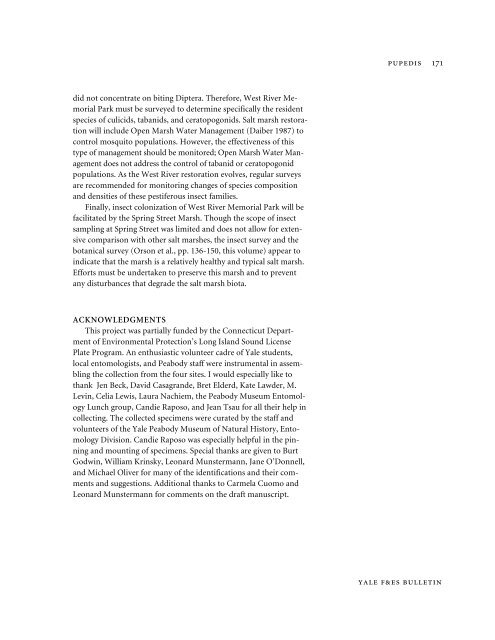Aquatic Insects of the West River and Salt Marshes ... - Yale University
Aquatic Insects of the West River and Salt Marshes ... - Yale University
Aquatic Insects of the West River and Salt Marshes ... - Yale University
You also want an ePaper? Increase the reach of your titles
YUMPU automatically turns print PDFs into web optimized ePapers that Google loves.
PUPEDIS 171did not concentrate on biting Diptera. Therefore, <strong>West</strong> <strong>River</strong> MemorialPark must be surveyed to determine specifically <strong>the</strong> residentspecies <strong>of</strong> culicids, tabanids, <strong>and</strong> ceratopogonids. <strong>Salt</strong> marsh restorationwill include Open Marsh Water Management (Daiber 1987) tocontrol mosquito populations. However, <strong>the</strong> effectiveness <strong>of</strong> thistype <strong>of</strong> management should be monitored; Open Marsh Water Managementdoes not address <strong>the</strong> control <strong>of</strong> tabanid or ceratopogonidpopulations. As <strong>the</strong> <strong>West</strong> <strong>River</strong> restoration evolves, regular surveysare recommended for monitoring changes <strong>of</strong> species composition<strong>and</strong> densities <strong>of</strong> <strong>the</strong>se pestiferous insect families.Finally, insect colonization <strong>of</strong> <strong>West</strong> <strong>River</strong> Memorial Park will befacilitated by <strong>the</strong> Spring Street Marsh. Though <strong>the</strong> scope <strong>of</strong> insectsampling at Spring Street was limited <strong>and</strong> does not allow for extensivecomparison with o<strong>the</strong>r salt marshes, <strong>the</strong> insect survey <strong>and</strong> <strong>the</strong>botanical survey (Orson et al., pp. 136-150, this volume) appear toindicate that <strong>the</strong> marsh is a relatively healthy <strong>and</strong> typical salt marsh.Efforts must be undertaken to preserve this marsh <strong>and</strong> to preventany disturbances that degrade <strong>the</strong> salt marsh biota.ACKNOWLEDGMENTSThis project was partially funded by <strong>the</strong> Connecticut Department<strong>of</strong> Environmental Protection’s Long Isl<strong>and</strong> Sound LicensePlate Program. An enthusiastic volunteer cadre <strong>of</strong> <strong>Yale</strong> students,local entomologists, <strong>and</strong> Peabody staff were instrumental in assembling<strong>the</strong> collection from <strong>the</strong> four sites. I would especially like tothank Jen Beck, David Casagr<strong>and</strong>e, Bret Elderd, Kate Lawder, M.Levin, Celia Lewis, Laura Nachiem, <strong>the</strong> Peabody Museum EntomologyLunch group, C<strong>and</strong>ie Raposo, <strong>and</strong> Jean Tsau for all <strong>the</strong>ir help incollecting. The collected specimens were curated by <strong>the</strong> staff <strong>and</strong>volunteers <strong>of</strong> <strong>the</strong> <strong>Yale</strong> Peabody Museum <strong>of</strong> Natural History, EntomologyDivision. C<strong>and</strong>ie Raposo was especially helpful in <strong>the</strong> pinning<strong>and</strong> mounting <strong>of</strong> specimens. Special thanks are given to BurtGodwin, William Krinsky, Leonard Munstermann, Jane O’Donnell,<strong>and</strong> Michael Oliver for many <strong>of</strong> <strong>the</strong> identifications <strong>and</strong> <strong>the</strong>ir comments<strong>and</strong> suggestions. Additional thanks to Carmela Cuomo <strong>and</strong>Leonard Munstermann for comments on <strong>the</strong> draft manuscript.YALE F&ES BULLETIN
















